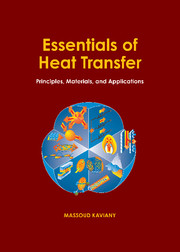Book contents
- Frontmatter
- Contents
- Preface
- Acknowledgments
- Guide to Instructors and Students
- 1 Introduction and Preliminaries
- 2 Energy Equation
- 3 Conduction
- 4 Radiation
- 5 Convection: Unbounded Fluid Streams
- 6 Convection: Semi-Bounded Fluid Streams
- 7 Convection: Bounded Fluid Streams
- 8 Heat Transfer in Thermal Systems
- Nomenclature
- Glossary
- Answers to Problems
- Appendix A Some Thermodynamic Relations
- Appendix B Derivation of Differential-Volume Energy Equation
- Appendix C Tables of Thermochemical and Thermophysical Properties
- Subject Index
7 - Convection: Bounded Fluid Streams
Published online by Cambridge University Press: 05 June 2012
- Frontmatter
- Contents
- Preface
- Acknowledgments
- Guide to Instructors and Students
- 1 Introduction and Preliminaries
- 2 Energy Equation
- 3 Conduction
- 4 Radiation
- 5 Convection: Unbounded Fluid Streams
- 6 Convection: Semi-Bounded Fluid Streams
- 7 Convection: Bounded Fluid Streams
- 8 Heat Transfer in Thermal Systems
- Nomenclature
- Glossary
- Answers to Problems
- Appendix A Some Thermodynamic Relations
- Appendix B Derivation of Differential-Volume Energy Equation
- Appendix C Tables of Thermochemical and Thermophysical Properties
- Subject Index
Summary
As the fluid passes along the wall in turbulent motion, fluid particles coalesce into lumps, which move bodily and cling together retaining their momentum for a given transverse length (a mixture or mixing length) and this is analogous to the mean-free path in the kinetic theory of gases.
– L. PrandtlA bounded fluid stream in thermal nonequilibrium with its bounding solid surface exchanges heat, and this alters its temperature across and along the stream. That this change occurs throughout the stream is what distinguishes it from the semi-bounded streams where the far-field temperature is assumed unchanged (i.e., the change was confined to the thermal boundary layer). We now consider the magnitude, direction, and spatial and temporal variations of qu in a bounded fluid stream (also called an internal flow) that is undergoing surface-convection heat transfer qku. As in Chapter 6, initially our focus is on the fluid and its motion and heat transfer (and this is the reason for the chapter title, bounded fluid streams); later we include the heat transfer in the bounding solid. We examine qu within the fluid and adjacent to the solid surface. As in Chapter 6, at the solid surface, where uf = 0, we use qku to refer to the surface-convection heat flux vector. We will develop the average convection resistance 〈Ru〉L, which represents the combined effect of surface-convection resistance and the change in the average fluid temperature as it exchanges heat with the bounding surface.
- Type
- Chapter
- Information
- Essentials of Heat TransferPrinciples, Materials, and Applications, pp. 570 - 658Publisher: Cambridge University PressPrint publication year: 2011



